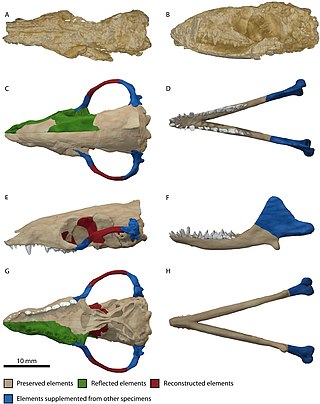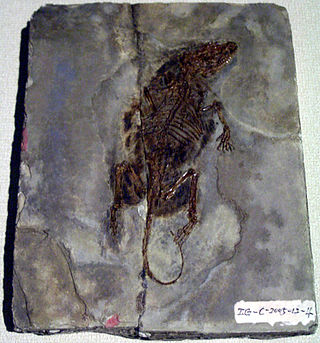
Sunnyodon is a genus of tiny, extinct mammal, probably of the Lower Cretaceous. Found in what is now southern England and Denmark, it was a relatively early member of the extinct order of Multituberculata. It is part of the suborder Plagiaulacida and family Paulchoffatiidae.
Gerhardodon is an extinct genus of mammal from the Lower Cretaceous of southern England. It was a member of the also extinct order of Multituberculata, and lived with such dinosaurs as Iguanodon. It lies within the suborder "Plagiaulacida" and family Pinheirodontidae.
Albionbaatar is an extinct mammal from the Lower Cretaceous Lulworth Formation of England. It was a member of the also extinct order Multituberculata and shared the world with the much larger dinosaurs. It is in the suborder "Plagiaulacida", family Albionbaataridae. The genus Albionbaatar was named by Kielan-Jaworowska Z. and Ensom P.C. in 1994 based on a single species.

Morganucodon is an early mammaliaform genus that lived from the Late Triassic to the Middle Jurassic. It first appeared about 205 million years ago. Unlike many other early mammaliaforms, Morganucodon is well represented by abundant and well preserved material. Most of this comes from Glamorgan in Wales, but fossils have also been found in Yunnan Province in China and various parts of Europe and North America. Some closely related animals (Megazostrodon) are known from exquisite fossils from South Africa.

Echinodon is a genus of heterodontosaurid dinosaur that lived during the earliest Cretaceous of southern England and possibly western France in the Berriasian epoch. The first specimens were jaw bones named Echinodon becklesii by Sir Richard Owen in 1861, and since their original description only additional teeth have been discovered. The specific name honours collector Samuel Beckles who discovered the material of Echinodon and many other taxa from across England, while the genus name translates as "prickly tooth" in reference to the dental anatomy of the taxon.

Trechnotheria is a group of mammals that includes the therians and some fossil mammals from the Mesozoic Era. It includes both the extinct symmetrodonts and the living Cladotheria.
Pantotheria is an abandoned taxon of Mesozoic mammals. This group is now considered an informal "wastebasket" taxon and has been replaced by Dryolestida as well as other groups. It is sometimes treated as an infraclass and older books refer to it as being related to symmetrodonts. One classification makes it an infraclass with a single order, Eupantotheria.
Tinodon is an extinct genus of mammal alive 155–140.2 million years ago (Oxfordian-Berriasian) which has been found in the Morrison Formation, the Alcobaça Formation (Portugal) and the Lulworth Formation (England). It is of uncertain affinities, being most recently recovered as closer to therians than eutriconodonts but less so than allotherians. Two species are known: T. bellus and T. micron.

Owenodon is a genus of iguanodontian dinosaur known from a partial lower jaw discovered in Early Cretaceous-age rocks of Dorset, United Kingdom, and possibly also Romania and Spain. The first and only definitive specimen was found in the Lulworth Formation of the Purbeck Limestone Group, dating to the middle Berriasian stage. It was first described by Richard Owen as a species Iguanodon, I. hoggii, honouring naturalist A.J. Hogg who had originally collected the fossil. Owen described the mandible as it was, partially embedded in a limestone block, but it was given to the Natural History Museum, London where it was accessioned as NHMUK PV R 2998 and further prepared. Some damage occurred to a tooth crown and part of the bone while stored in the collections. Redescription of I. hoggii by David Norman and Paul Barrett subsequently transferred the species to Camptosaurus in 2002, as well as tentatively referring other camptosaur-like material from the Purbeck beds to the species. The identity of the species was questioned, with Kenneth Carpenter and Yvonne Wilson, and Greg Paul, separating "C." hoggi from Camptosaurus as an intermediate ornithopod, until Peter Galton named the new genus Owenodon for it in 2009. Galton removed the material assigned by Norman and Barrett from Owenodon, but referred isolated teeth from the Bauxite of Cornet, Romania, and the El Castellar Formation of Spain to O. hoggii. The taxon, believed by Galton to be intermediate between Camptosaurus and Iguanodon, is of uncertain relationships, with the limited material preventing clear understanding of its position within ornithopod evolution. Phylogenetic studies have found Owenodon to be more primitive, equivalent to, or more derived than Camptosaurus, but it is often excluded to improve results.
Several mammals are known from the Mesozoic of Madagascar. The Bathonian Ambondro, known from a piece of jaw with three teeth, is the earliest known mammal with molars showing the modern, tribosphenic pattern that is characteristic of marsupial and placental mammals. Interpretations of its affinities have differed; one proposal places it in a group known as Australosphenida with other Mesozoic tribosphenic mammals from the southern continents (Gondwana) as well as the monotremes, while others favor closer affinities with northern (Laurasian) tribosphenic mammals or specifically with placentals. At least five species are known from the Maastrichtian, including a yet undescribed species known from a nearly complete skeleton that may represent a completely new group of mammals. The gondwanathere Lavanify, known from two teeth, is most closely related to other gondwanatheres found in India and Argentina. Two other teeth may represent another gondwanathere or a different kind of mammal. One molar fragment is one of the few known remains of a multituberculate mammal from Gondwana and another has been interpreted as either a marsupial or a placental.
Dorsetodon is an extinct genus of mammal from the Early Cretaceous (Berriasian) Purbeck Group of Britain. It is represented by isolated lower molars.
Donodon is an extinct genus of mammal from the Ksar Metlili Formation of Talssint, Morocco, which has been dated to the Late Jurassic to Early Cretaceous epochs. The type species D. perscriptoris was described in 1991 by the palaeontologist Denise Sigogneau-Russell. A second species, D. minor, was named in 2022. Donodon was a member of Cladotheria, a group that includes therian mammals and some of their closest relatives. It differed from dryolestids in having upper molars that were not compressed mesiodistally. Some studies have suggested that it was closely related to various South American cladotherians in the clade Meridiolestida, with specific similarities to Mesungulatum, a herbivorous mesungulatid, being noted. On the other hand, a 2022 phylogenetic analysis found it to be only distantly related to meridiolestidans, and instead closer to crown group therians.
Purbeckodon is an extinct genus of mammaliaforms, possibly belonging to Morganucodonta, that is known from Early Cretaceous deposits of southeastern Dorset, England. It was collected in the Purbeck Limestone Group of Dorset. It was first named by Percy M. Butler, Denise Sigogneau-Russell and P. C. Ensom in 2011 and the type species is Purbeckodon batei.
Aegialodontia is a clade of extinct early mammals, close to the origin of Boreosphenida. The clade includes some of the oldest known tribosphenic taxa, until the discovery of Tribactonodon from the Berriasian Durlston Formation in 2001, Aegialodon from the Valanginian Wadhurst Clay Formation was the oldest taxon with the tooth form. The Aptian to Albian taxon Kielantherium from Mongolia, formerly a synonym of Aegialodon, is also within the group, sister to Aegialodon within Aegialodontidae.
Spalacotherium is a genus of extinct mammal from the Early Cretaceous of Europe. The type species Spalacotherium tricuspidens was originally named by Richard Owen in 1854, and its material includes maxillary and dentary fragments and many teeth from the Berriasian Lulworth Formation of southern England. Referred species include S. taylori, S. evansae and S. hookeri also from the Lulworth deposits, and S. henkeli from Barremian deposits of Galve, Spain. The Lulworth taxon Peralestes longirostris, named by Owen in 1871, is a junior synonym of the type species S. tricuspidens. Spalacotherium is the namesake taxon of the family Spalacotheriidae, which is an extinct clade within Trechnotheria that may be closely related to the Gondwanan clade Meridiolestida, or united with the family Zhangheotheriidae to form Symmetrodonta.S. evansae is also from the Berriasian aged Angeac-Charente bonebed in western France.
Thereuodon is a genus of extinct mammal known from the Early Cretaceous of southern England, Morocco and France. The type species, named by Denise Sigogneau-Russell in 1989 for teeth from the earliest Cretaceous Ksar Metlili Formation of Morocco, is Thereuodon dahmani, while the referred species named by Sigogneau-Russell and Paul Ensom for teeth from the Lulworth Formation of England is Thereuodon taraktes. The two species are separated by a break in the cingulum in T. dahmani, a more obtuse medial crest in T. taraktes, a duller stylocone in T. taraktes, a "c" cuspule in T. dahmani, and a reduced facet A in T. taraktes. The genus Thereuodon is the only taxon in the symmetrodont family Thereuodontidae, which may be closely related to Spalacotheriidae. A tooth referred to T. cf. taraktes is known from the Berriasian aged Angeac-Charente bonebed of France.
Magnimus is a genus of extinct mammal from the Early Cretaceous of Southern England. The type and only species is Magnimus ensomi, described in 1999 by Denise Sigogneau-Russell for molars from the Berriasian Lulworth Formation. The specific name was given to honour Paul Ensom, a discoverer of many teeth from the Purbeck beds, while the generic name is from the Latin words for "large" and "mouse". It is similar to but distinct from Peramus and Abelodon, but its classification cannot be narrowed down beyond indeterminate Zatheria due to its incomplete nature.

Durlstodon is a genus of extinct mammal from the Early Cretaceous of Southern England. It contains a single species, Durlstodon ensomi, which is known from molars found in the Berriasian Lulworth Formation of Durlston Bay, Dorset, after which the genus was named. The species name honours Paul Ensom, discoverer of many fossil mammals from Lulworth. Durlstodon and two of its contemporaries, Tribactonodon and Durlstotherium, had tribosphenidan (three-cusped) molars, which are an advanced characteristic among eutherian mammals and suggest that the group emerged earlier than the Early Cretaceous.
Denise Sigogneau-Russell is a French palaeontologist who specialises in mammals from the Mesozoic, particularly from France and the UK. She is currently based at the Muséum National d'Histoire Naturelle.
Dobunnodon its an extinct genus of docodont from the Middle Jurassic (Bathonian) Forest Marble Formation of England, first discovered in Oxfordshire near the village of Kirtlington. The type species, D. mussettae, was originally named as a species of Borealestes in 2003.










